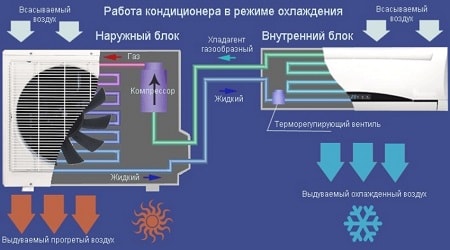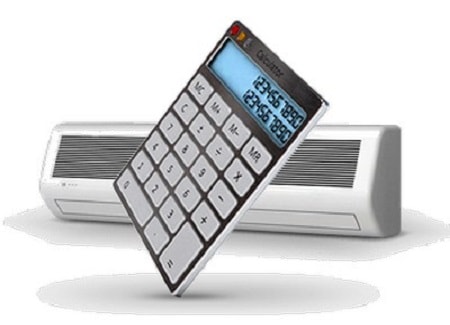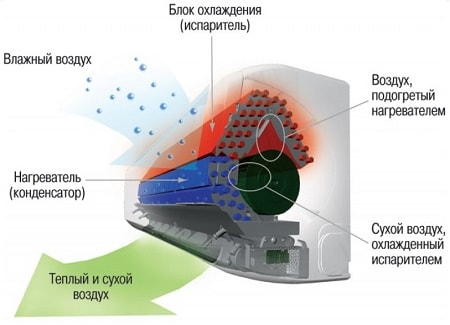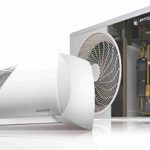With the onset of summer, do you dream of living in a refrigerator? Fans and drafts don't help? It's time to get air conditioning. How to choose air conditioners for an apartment in 2017? We will talk about this.
Air conditioner in theory

Before you figure out how to choose the right air conditioner, you need to understand what kind of device it is. But there is no magic here. Only physics. Elementary.
Air conditioning systems are closed-loop systems in which the aggregate state of the refrigerant changes. This happens due to changes in temperature and internal pressure. The liquid evaporates, turns into gas and absorbs thermal energy. And with the reverse transformation (from gas to liquid) - it gives it away.
Simply put, an air-conditioned design does not generate cold. It takes heat from your apartment and transfers it to a condenser installed outside it. All refrigerant work is supervised by the compressor.
Modern refrigeration structures are capable of not only "stealing", but also "bringing" heat into the house. If you do not go into the technical details of the process, we can say that the condenser and the evaporator change roles.
By the way, the first air conditioning was developed far from for “heavenly conditions” in the room. His task was to save one American printing house from high humidity, which spoiled print quality. And this means that without exception, all “producers of cold”, along with heat, absorb moisture.
Poorly humidified air is the main cause of many respiratory diseases. Of course, choosing an air conditioner is an important step, but you should not forget about health. Therefore, before buying a device, do not be too lazy to install additional sources of air humidification.
See also:
- 5 best Toshiba air conditioners of the year
- 5 best Panasonic air conditioners of the year
- 5 best LG air conditioners of the year
- 5 best Daikin air conditioners of the year
- 6 best Mitsubishi Electric air conditioners of the year
From theory to practice, or what are air conditioners
How to choose an air conditioner for your home? To begin with, what types of air conditioners for your apartment can be found on the modern home appliance market. Do you think there are many of them? It seemed to you. In fact, there are only two types of household cooling systems:
- split systems;
- monoblock devices.
![]() See also - Which air conditioner manufacturer is the best in terms of price and quality?
See also - Which air conditioner manufacturer is the best in terms of price and quality?
What are split systems

Split systems are the lion's share of the market in the air conditioning segment. They consist of a pair of blocks.One is placed in the living room, the second is displayed outside. Between themselves they are connected by copper tubes (refrigerant circulates through them) and an electric wire.
Split systems are: wall, channel, invertor, columned, cassette, floor-to-ceiling, multi split systems. Let us examine in more detail the advantages and disadvantages of each of the designs.
- Wall split system. Cheap and quite powerful (2-10 kW). Its indoor unit is installed above the window in the room, and the outdoor unit under it on the outside of the building. This unit is an excellent solution for cooling small rooms (10-100 m²).
- Channel split system. Hidden behind a false ceiling. It works on the principle of heat-protected ducts. Creates a favorable microclimate in several rooms at the same time. The advantage of a ducted air conditioner is that it supplies air in the volumes that are needed for comprehensive ventilation of the conditioned areas.
- Cassette split system. It is mounted in the same way as a channel split system. But the air "cassettes" disperse through the lower block, the size of which is 60x60 cm (like a standard ceiling plate). But power dictates the size. The more powerful the unit, the more it is. The main advantage is inconspicuousness. The unit is hidden from view and covered with a grill. Designed for cooling large areas.
- Column split system. This is ideal for large rooms that need powerful cold supply. The system is installed on the floor, away from people.
- Floor-ceiling split system. An excellent alternative to a “cassette” in the absence of a false ceiling. You can install such air conditioners both at the bottom and at the top of the wall. Their placement dictates the trajectory of the air flow. The advantage of this split system is that the coolness is distributed evenly throughout the room, without harming those present in it.
- Multi split system. A unique modification of split systems that allows you to connect up to five indoor units of various designs and performance. Units of this type are installed where there is no possibility of outputting external units to the outer wall of the building. They have a significant drawback - disconnecting an external unit leads to disconnection of all internal ones.
- Inverter split system. It is a separate type of air conditioner with a frequency controlled compressor motor. The inverter converts AC to DC and vice versa. During the second conversion, the engine speed changes. This allows you to adjust the cooling power and heat. Unlike all other types of air conditioners, the inverter operates constantly. First at full power to achieve the set temperature, and then at low power to maintain it. At the same time, power consumption is 20-50% lower than in simple cooling systems. Plus, compressor wear is reduced and noise levels are reduced.
![]() See also - Which outdoor air conditioner is best for home
See also - Which outdoor air conditioner is best for home
What are monoblock air conditioners
Monoblock refrigeration units are also divided into two groups:
- Window. They are mounted in windows or a thin wall so that the backside is outside the building, that is, on the street. Advantages - low price and ease of installation. The disadvantages of such an air conditioner for an apartment include a high noise level and a violation of the thermal insulation of the room.
- Mobile Stand out from the others for their portability. They are easy to install and move freely inside the building. The system is easy to operate, but not efficient. Cons: noise, cost, low level of maintaining a comfortable indoor climate.
![]() See also - How to repair an air conditioner yourself
See also - How to repair an air conditioner yourself
Power is our everything

Oh so much! Don't panic. Let's figure out how to choose the most suitable air conditioners for the apartment, so that it is of high quality, and inexpensive, and beautiful. Go!
- Decide what you are buying the unit for.
- Take measurements. Write down the parameters and type of room to be cooled.
- Decide how much money you want (you can) spend on buying an air conditioner.
Are you done? Now let's talk about the performance of the units. That is, how much coolness or heat this or that air conditioner can “nudge” from the space. If you calculate the wrong power and buy the wrong one, you:
- waste money on a “weak” device that is unable to meet your requirements;
- you will acquire a powerful unit, the potential of which is much higher than what is needed for the room where it is installed.
How to avoid this? When choosing a cooling system, consider the following parameters:
- Calculate the approximate consumption of "chill" by the formula: 1,000 watts per 8 m².
- If direct sunlight penetrates the building for at least half of the day, add another 20-30% to the resulting figure.
- Now add to this the amount of excess heat from the electrical appliances in the room. On average, this is 30% of the power that is consumed by a particular device.
- To the result obtained we add the excess heat of all people who are in this room (100 W / person - home / office, 150-300 W / person - catering and gym, respectively).
If you count laziness, rely on the approximate data of the plate:

Air conditioning and its functions

How to choose the air conditioner according to the parameters? What to look for? What function is it worth paying for? What else can surprise the cooling system? If these questions continue to arise in your head, let's look for answers together. Let's start with the main one.
- Cold and warm. This, in fact, is what the device is purchased for. If everything is clear with cooling, then it would not hurt to deal with heating. There are some nuances here.
Any air conditioner you choose will not save you from frost. And all because the lower limit of the temperature regime of the device is no more than 5 degrees in both directions. The use of air conditioning in the winter quickly wears out the compressor or leads to its breakdown.
To avoid this, the manufacturer equips the air conditioner with additional “winter sets”, which significantly increase the cost of the unit. In this case, the efficiency of the device at minus temperature is reduced by more than 30%. In general, you will not be able to enjoy the desired warmth from the air conditioner, and there can be no question of heating the entire room. It is more expedient to use cheaper and more efficient "old" methods of heating residential (and not only) premises.
- Ventilation. Required base function. In this mode, the motor "sleeps", and only the indoor unit fan works, which helps to evenly distribute the air around the entire perimeter of the room.
- Auto mode. The air conditioner decides which function to activate. Of course, depending on external circumstances (temperature, humidity, pressure). You don't have to pick anything up. The unit will do everything for you.
- Drying. In this mode, the air conditioner reduces the humidity in the air.
- Airflow direction adjustment. A useful feature that will save you and those around you from direct contact with cold air flow. Rest assured, now nothing will "blow" you out of your usual rut.
- Timer. Useful thing for the "forgetful." Just set the time for turning on and off the unit and do not worry about anything.
- Night mode. Creates the most "comfortable" cool conditions for sleeping. Engine speed decreases, noise decreases. After seven hours, the device automatically turns off.
- Mounting. It should not be saved. Correct installation of the air conditioner is the key to its long-term operation. Please note that this service is not cheap. Installation of the unit will cost you at least 30% of its cost. But this is much cheaper than subsequent (possibly repeated) repairs.
![]() See also - 10 best bathroom fans
See also - 10 best bathroom fans
The price issue is cool at home
How to choose the right air conditioners for an apartment? If you are looking to buy a technical piece of art, then you should pay attention to the top class units. They are produced exclusively by Japanese corporations, and include the most "delicious" technical developments of our time.
Air conditioners in the middle price range are produced by both Japanese and European manufacturers. These units are of high quality, but have a shorter service life than their expensive counterparts.
The budget market belongs to Korea and China. In this segment, there are no clear rules of the game for either quality or price. Such air conditioners are assembled from cheaper materials, have modest functionality and short service life. In some cases (a sharp change in pressure, temperature, humidity), a cheap unit can turn into a threat to your life.
Before making a choice, weigh the pros and cons. Compare the technical characteristics of the models you like. Don't chase cheapness. A quality product + professional installation is a guarantee of your safety for many years to come.
Did this article answer the question of how to choose air conditioners for an apartment in 2017? Leave your comments. It is important for us to know your opinion in order to get better. Until next time!
See also:
- 7 best Hisense air conditioners according to customer reviews
- 9 best Electrolux air conditioners of the year
- The 10 best Ballu air conditioners of the year
- Top 10 General Climate air conditioners according to customer reviews
- 20 best air conditioners for home


